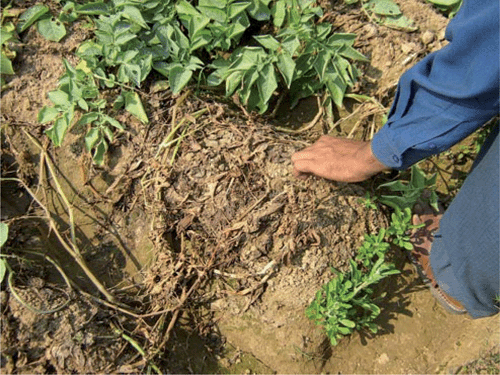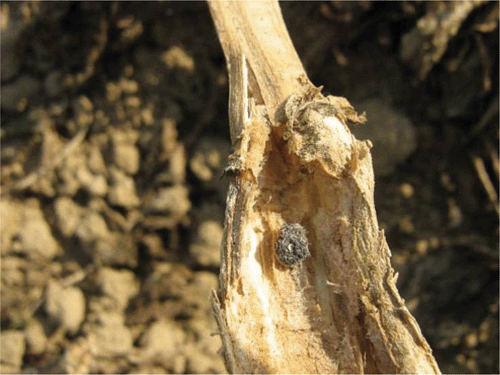Stem rot, a new disease of potato in West Bengal, India
S. Dutta A B , P. P. Ghosh A and S. P. Kuiry AA Plant Health Clinic Unit, Directorate of Research, Bidhan Chandra Krishi Viswavidyalaya, Kalyani, Nadia, 741235, West Bengal, India.
B Corresponding author. Email: subrata_mithu@yahoo.co.in
Australasian Plant Disease Notes 4(1) 80-81 https://doi.org/10.1071/DN09034
Submitted: 21 July 2009 Accepted: 29 July 2009 Published: 10 August 2009
Abstract
After observing severe symptoms of Sclerotinia sclerotiorum on the lower parts of potato plants some sclerotia were sampled. Infected plants were taken from the field and isolations from those plants yielded Sclerotinia sclerotiorum, which was identified on the basis of morphology. This is the first report of Sclerotinia sclerotiorum on potato in West Bengal, India.
Potato is one of the most important cash crops during Rabi season (winter season) in West Bengal, India. During the second fortnight of January 2009, severe stem rot of potato was observed in different farmers’ fields in Baikuntapur village, Hooghly, West Bengal, India and nearly 60% crop loss has been recorded in the infected fields as high humidity along with high fog intensity aggravated the rotting of the plants. The crops in the infected fields are generally infected at about 6 weeks of age when the stems of the plants contact the soil and initially water-soaked spots usually appear at the point where stems attach to branches, or on branches or stems in contact with the soil. A white cottony growth of fungal mycelium develops on the lesions, and infected tissue becomes soft and watery. The fungus may spread rapidly to nearby stems and leaves if moisture is present for several hours. Lesions then may expand and girdle the stem, causing stem rotting and death of the plant (Fig. 1). During dry conditions, lesions become dry and turn tan, or are bleached white and are papery in appearance. Hard, irregularly shaped resting bodies of the fungus, sclerotia, form in and on decaying plant tissues. Stems are frequently hollowed out by the fungus leaving a papery shell to cover numerous sclerotia (Fig. 2). Sclerotia eventually fall to the ground as infected stems dry out and the host plant dies. Infected plants were taken from the field and isolations from field-grown plant yielded Sclerotinia sclerotiorum, which was identified on the basis of morphology.

|

|
The fungus Sclerotinia sclerotiorum was maintained in potato dextrose agar (PDA) culture and multiplied for 15 days on sterilised wheat grains at 27°C and colonised grain served as the source of inoculum for artificial inoculation. Forty-day-old healthy plants were inoculated with a few colonised grain through slight insertions in the intersections between the stems and branches. Five plants were inoculated with sterile wheat grains. All inoculated plants were misted to runoff and bagged in plastic for 3 days to maintain high humidity. The bags were removed after 72 h. Three days after inoculation the initial lesions developed and disease progressed rapidly under humid conditions. Sclerotinia sclerotiorum was recovered from all inoculated plants, but not from control plants, which remained asymptomatic. There has been a previous report of S. sclerotiorum causing disease in potato, from Kota, Rajasthan, India (Singh and Agrawat 1989). This appears to be the first report of this disease from West Bengal, India.
Acknowledgements
The authors would like to thank Dr S. Jha for his guidance and excellent technical assistance and Bayers Crop Science Ltd, Kolkata, for assistance in field level investigations.
Singh RB, Agrawat JM
(1989) Outbreak of Sclerotinia white mould disease in India. Current Science 58, 456.



